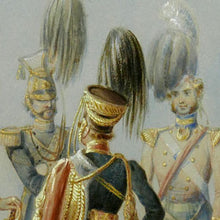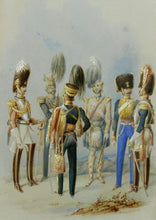British Military Fashion by Heath, 1830
- Regular price
- £1,450
- Sale price
- £1,450
- Regular price
-
- Unit price
- /per
Adding product to your cart
Overall: 49cm (19in) x 40cm (15.7in)
Provenance: Colonel George Powlett Cameron, C.B. (1806–1882)
By descent to Air Commodore R. Sorrell-Cameron, C.B.E., A.F.C. (1911-2001)
Watercolour on paper. Officers in review order of The Life Guards, 17th Lancers, Light Dragoons, 42nd Royal Highlanders, Royal Artillery and Royal Horse Guards. Signed lower right ‘HHeath ‘Delt’ (abbreviation of the Latin delineavit (he drew). Image: 31cm (12.2in) x 22cm (8.5in). Framed and glazed.
The signature on the present watercolour appears to be ‘I-I-Ieath’ and is interpreted as that of William (1794-1834) - a prestigiously talented military painter, caricaturist and print maker. As a caricaturist he was widely imitated resulting different signatures to his works. As a military artist he carried out collaborative projects with publishers and undertook private commissions of which the present watercolour is fine example.
Read more
Heath was born in Northumberland and was producing work by the age of fourteen. Despite an apparent absence of any formal training, he was well read and appears to have moved with ease in the louche world of Regency period London. His early works often dealt with military scenes, and included the colour plates for the ‘Martial Achievements of Great Britain and Her Allies; From 1799 to 1815’. He also worked with publisher Daniel Orme in producing the designs for the paper roundels featuring Wellington’s victories. Later caricatures portrayed Wellington the prime minister in a less flatteringly but equally popular light as a lobster, dog and jackass.
In about 1820 he took up residence near Hannah Humphrey's well known print shop at 27 St James's Street, through which he published numerous social satires. Ladies fashion, smoking, drinking, and gambling, were recurring themes and which might well have caused the historian Dorothy George to comment that the 29-year-old Heath was a person of extraordinary talents marred by careless habits, drinking, debts, and unpunctuality.
However a best selling project of this period was Heath’s ‘The Life of a Soldier’ (1823) comprising 18 engravings together with a long narrative poem written by the artist. Between 1827 and 1829, many of Heath’s satirical works were published under the pseudonym Paul Pry (from the name of very inquisitive character in a comedy of 1825 by John Poole) with doodle of the character in a lower corner; the figure was soon copied by other caricaturists, and so from 1828 Heath began to sign his work with his name. He was described by the biographer of the caricaturist John Leech as ‘poor Heath, the ex-Captain of Dragoons, facile and profuse, unscrupulous and clever’. By the end of the decade. Heath was living at Shawfield Cottage on Kings Road, Chelsea, or at least that was where he continued the production and publication of military costume watercolours and plates - ‘Military Costume of the British Cavalry’, (c1827) and ‘Costume of the British Army' (1828). It is thought Heath may have sold these over a number of years in volumes with whatever selection the buyer requested. Also at this time, he partnered with the print maker Henry Heath (apparently no relation) to produce the series fancy ‘Costumes and Regimentals of the British Army’ for William Bell’s newly established ‘Gentleman’s Magazine of Fashion’, 1828 to 1831.
Colonel George Powlett Cameron, C.B., (1806–1882) was the son of Royal Navy captain killed in action during the Napoleonic Wars. He was destined for the British Army but following the reduction in its size entered the East India Company’s military service in 1821. He saw active service as Adjutant of a light infantry battalion in South Mahratta country in 1824-5. He returned to England in 1831 and ‘gave vent to his youthful energy’ by joining the expedition to Portugal under the Duke of Braganza to recover the throne for his daughter Queen Maria II. Cameron distinguished himself leading a charge of the Scotch Fusiliers at Oporto and later as Chef d’Etat Major of the Third division made up of French, German and Light Brigades, being twice wounded and awarded the Royal order of Merit of the Conception and the Order of the Tower and Sword. The Court of Directors of the East India Company next sent him to Constantinople on a special mission, which led him on to Persia, where, under the orders of the Prince Royal, he commanded the garrison at Tabriz and troops stationed in Azerbaijan. He afterwards travelled to the North Caucasus and visited Russian fortresses on the Black Sea, no doubt gathering intelligence. On his return home he was made a Companion of the Bath. Cameron returned to India to become Political Resident at Chepauk Palace, Chennai, and guardian to the young Nawab of Arcot. After a prolonged disagreement with the Governor-General of Madras, Lord Tweedale, Cameron left India, and made extensive travels through Egypt. During the year of revolutions 1848 he was in northern Italy, and returned to southern India top command in the Nilgri Hills. In 1859 he was with the Austrian army during the their defeat in 1859 by Sardinia, aided by France. He was the author wrote an account of his travels, 1845, and The Romance of Military Life, 1853.






